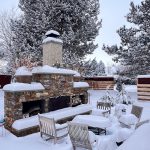
 Spring calls for housekeeping in the garden, or “gardenkeeping” I’ll call it. We are all itching to get out there and plant. In addition to garden fun, many routine tasks call for attention at this time. Foundation plantings and beds need to be cleaned out by removing leaves and dead foliage to improve appearance and prevent disease. Before new growth appears is also a good time to prune trees and shrubs. Careful- don’t prune any plants that are spring-blooming.
Spring calls for housekeeping in the garden, or “gardenkeeping” I’ll call it. We are all itching to get out there and plant. In addition to garden fun, many routine tasks call for attention at this time. Foundation plantings and beds need to be cleaned out by removing leaves and dead foliage to improve appearance and prevent disease. Before new growth appears is also a good time to prune trees and shrubs. Careful- don’t prune any plants that are spring-blooming.
 If you are a DIY person, your lawn is calling for attention too, but not in the way you might think. According to the local Extension Offices (central Virginia,) it is best not to fertilize fescue lawns at this time because spring fertilization encourages top, blade growth at the expense of root growth. If you have followed the fall fertilization program, the lawn has plenty of nutrients to sustain it through the spring and summer. If you haven’t, it’s still best to wait until fall rolls around again to fertilize. It’s also ecologically sound only fertilize when the plants can best utilize the nutrients so the chemicals don’t end up in the Chesapeake Bay or our ground water. I am a big believer in less is more when using fertilizers and pesticides in the garden.
If you are a DIY person, your lawn is calling for attention too, but not in the way you might think. According to the local Extension Offices (central Virginia,) it is best not to fertilize fescue lawns at this time because spring fertilization encourages top, blade growth at the expense of root growth. If you have followed the fall fertilization program, the lawn has plenty of nutrients to sustain it through the spring and summer. If you haven’t, it’s still best to wait until fall rolls around again to fertilize. It’s also ecologically sound only fertilize when the plants can best utilize the nutrients so the chemicals don’t end up in the Chesapeake Bay or our ground water. I am a big believer in less is more when using fertilizers and pesticides in the garden.
 At this time your lawn does need pre-emergent crab grass and broad-leaf weed control. This can be applied in granular form or spray, carefully following the recommendations by the manufacturer for application. Nature gives us the schedule for the first application of crab grass control. It is ideally applied before the last Forsythia blooms fall. Spring is also a great time to get a soil test which is always a first step, and begin applications of lime if that is indicated. Always check the forecast prior to applying any chemicals to the lawn or garden. A heavy rain will quickly wash your efforts and dollars away.
At this time your lawn does need pre-emergent crab grass and broad-leaf weed control. This can be applied in granular form or spray, carefully following the recommendations by the manufacturer for application. Nature gives us the schedule for the first application of crab grass control. It is ideally applied before the last Forsythia blooms fall. Spring is also a great time to get a soil test which is always a first step, and begin applications of lime if that is indicated. Always check the forecast prior to applying any chemicals to the lawn or garden. A heavy rain will quickly wash your efforts and dollars away.
Next post… more on the spring garden!
Related posts:
No related posts.
Tags: Landscape design, spring
Leave a Reply Cancel reply

More Story
Let There Be Light... outside
EXTERIOR LIGHTING No longer limited to the typical wall fixtures and light posts, outdoor lighting now has a myriad...Subscribe to the Blog
Site Menu
Recent Posts
- What's a gardener to do... in winter?
Jan 22, 2024 - New Year, New Plans!
Jan 1, 2024 - The Thoughtful Host
Dec 7, 2023
- What's a gardener to do... in winter?

You may link to a post or take quotes if credit, including a link back, is given.
You may not take entire posts or photographs without asking.
Permission may be requested using the contact form .












Share On